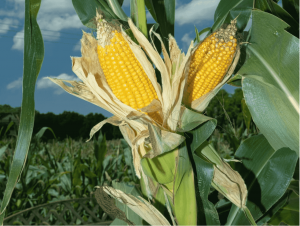
The absorption of nitrogen, phosphorus, and potassium by corn varies significantly at different growth stages. During the seedling stage, the plants are small, grow slowly, and require less fertilizer, absorbing about 10% of the total nutrients. From the jointing to the tasseling stage, the absorption rate peaks, with nitrogen and phosphorus uptake accounting for 76.2% and 63.1% of the total within 20-30 days. After that, the absorption slows down, and by the tasseling stage, nitrogen and phosphorus uptake has reached 90%
Characteristics of Nitrogen Deficiency in Corn
Symptoms of Nitrogen Deficiency in Corn:
During the seedling stage, nitrogen deficiency in corn results in slow growth, stunted and slender plants, and yellow-green leaves, with delayed tasseling. Nitrogen is a mobile element, so the yellowing of leaves begins with the older leaves at the lower part of the plant. Initially, the leaf tips turn yellow, and the yellowing gradually spreads along the midrib, forming a “V” shape. The middle part of the leaf turns yellow before the edges, with veins showing a slight red tint. Once the entire leaf turns yellow, the leaf sheath will become red, and soon the whole leaf will turn yellow-brown and die. In cases of moderate nitrogen deficiency, the middle leaves of the plant appear pale green, while the upper tender leaves remain green. If corn fails to absorb enough nitrogen during the later growth stages, tasseling will be delayed, and the female ears will not develop properly, leading to reduced yields.
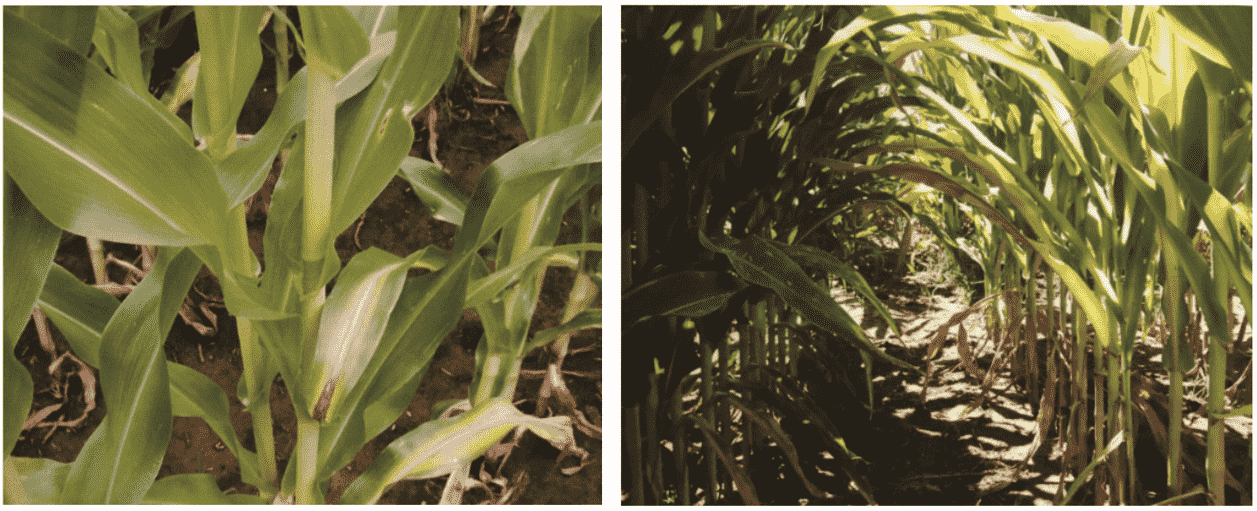
Causes of Nitrogen Deficiency in Corn
Corn grows rapidly, accumulates a large amount of biomass, and has a high nitrogen requirement. In China, nitrogen deficiency commonly occurs in corn fields relying solely on soil nitrogen supply. Soils with low organic matter content are prone to nitrogen deficiency. Nitrogen is also easily lost in high rainfall areas, and nitrogen deficiency symptoms can occur under low temperatures, waterlogging, or drought conditions.
Prevention and Remedies for Nitrogen Deficiency in Corn
Determine the amount and method of nitrogen application based on soil fertility and yield level. For corn fields with medium fertility, generally apply 11–13 kilograms of pure nitrogen per acre. In summer corn, apply in three stages: the first application at the seedling stage accounts for 20% of the total nitrogen; the second application at the big collar stage accounts for 70%; the third application at the tasseling and flowering stage accounts for 10% of the total nitrogen. When nitrogen deficiency symptoms occur in the grain, apply a foliar spray of 1%–2% urea solution, spraying twice.
Corn Phosphorus Deficiency Symptoms
Phosphorus deficiency in corn results in poor root development and slow growth during the seedling stage. The most prominent feature is that the tips and edges of young leaves turn purplish-red, while the rest of the leaf remains green or gray-green, with a lack of luster and weak stems. As the plant matures, the purplish-red color gradually fades, and the lower leaves turn yellow. Some hybrid varieties may not show the purplish-red symptoms under phosphorus deficiency, so it's important to consider the variety characteristics for a comprehensive analysis. Corn plants with phosphorus deficiency are noticeably shorter than normal plants, which can affect pollination and grain filling, leading to short and poorly filled ears, severe tip blanks, uneven grain arrangement, more shriveled grains, and delayed maturity.
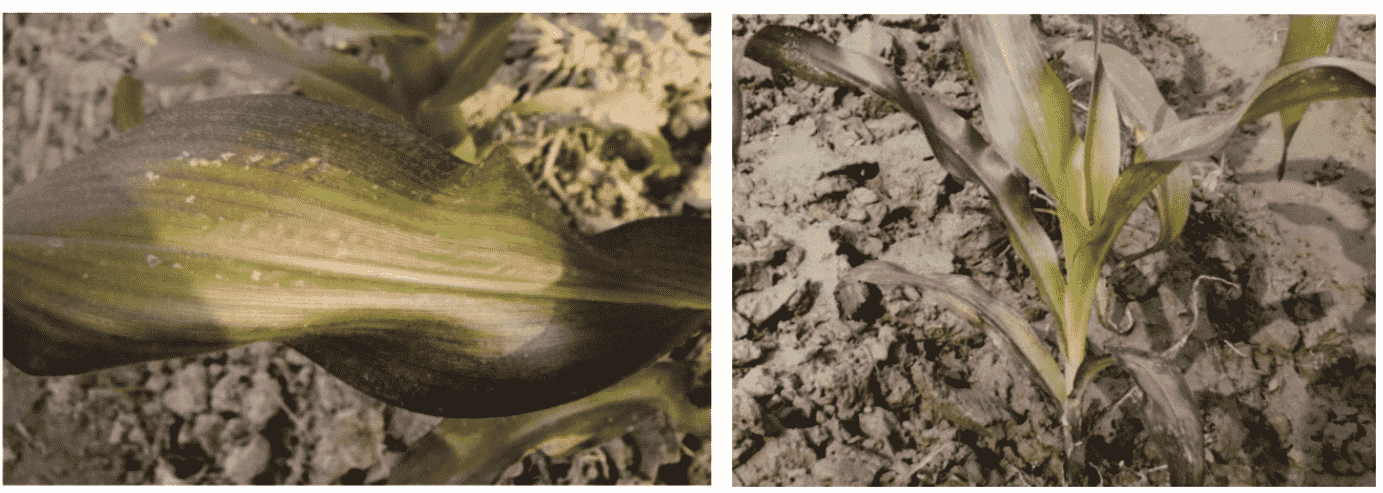
Causes of Phosphorus Deficiency in Corn
Phosphorus deficiency in corn is related to the soil's effective phosphorus content. The effective phosphorus content is low in yellow soils. In calcareous soils, acidic soils, and red soils, phosphorus is easily fixed, reducing its availability. Phosphorus deficiency is also more likely to occur during low temperatures, excessive moisture, or drought conditions. Soil compaction affects root growth, weakening the plant's ability to absorb phosphorus. An excessive amount of nitrogen fertilizer can cause nutrient imbalances in the plant. Insufficient phosphorus fertilizer, late application, or improper placement can also lead to phosphorus deficiency symptoms.
Prevention and Remedies for Phosphorus Deficiency in Corn
Phosphorus fertilizer is usually used as a base fertilizer. Under normal fertilization levels, phosphorus fertilizer should be evenly concentrated in the corn root zone, which helps the roots maintain suitable soil moisture and prevent drought stress. If phosphorus deficiency symptoms appear in corn, apply 20 kilograms of superphosphate per acre as a basal application early on, and provide timely top-dressing with water-soluble phosphorus fertilizer. In the later stages, foliar spray with a 0.2%–0.5% potassium dihydrogen phosphate solution 2–3 times.
Corn Potassium Deficiency Symptoms
Potassium deficiency in corn leads to poor root development, slow plant growth, and pale green to yellow-green striped leaves. In severe cases, the leaf edges and tips turn purplish and then become scorched and dry. The middle parts of the leaves may remain green, but the leaves gradually deteriorate. The plants appear weak, are more susceptible to diseases, prone to lodging, and have poorly developed ears. There is severe tip blanking, reduced starch content in the kernels, and the ears are more susceptible to disease.
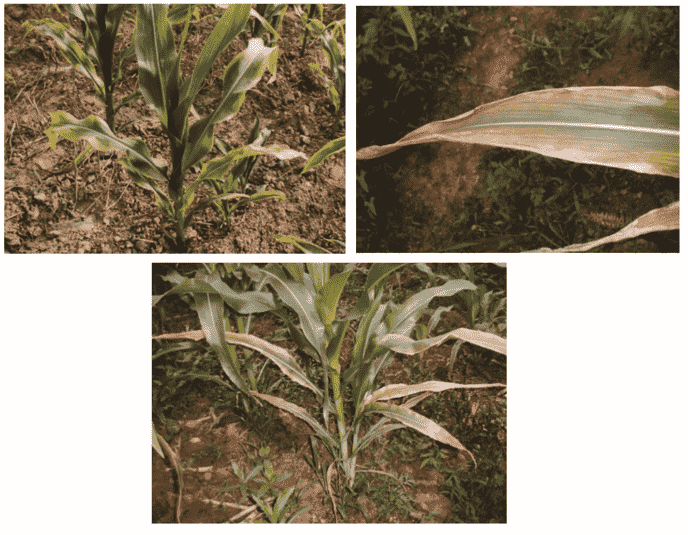
Causes of Potassium Deficiency in Corn
In China, a large proportion of farmland soil is deficient in potassium. With the promotion and application of high-yield varieties, the amount of potassium removed from the soil during harvest has increased, leading to a larger area of potassium deficiency and more severe deficiency symptoms. Generally, sandy soils have low potassium content and are prone to potassium deficiency. Potassium deficiency symptoms are also common during dry seasons. Unreasonable cultivation practices, poor soil permeability in waterlogged areas, or both drought and excessive moisture can contribute to potassium deficiency. Recently, the reduced proportion of organic fertilizers and the increased use of nitrogen and phosphorus fertilizers have been major causes of potassium deficiency. Excessive application of nitrogen fertilizer can lead to potassium deficiency symptoms in corn.
Prevention and Remedies for Potassium Deficiency in Corn
Determine the potassium fertilizer amount based on target yield and soil available potassium levels, generally applying 6–8 kilograms of pure potassium (K2O) per acre. Potassium fertilizer should be applied in two stages: a basal application and a top-dressing, with a recommended ratio of 7:3. This is particularly important in rainy areas and sandy soils. Tillage and maintaining soil looseness and aeration help improve potassium availability. Strengthen field management to prevent soil drought and waterlogging, which helps prevent potassium deficiency. Utilize various potassium fertilizer resources effectively, including increasing the application of ash and organic fertilizers, and returning straw to the field. If potassium deficiency symptoms appear in corn, apply 10–15 kilograms of potassium chloride per acre or 100 kilograms of ash at the jointing stage; foliar spray with 0.2%–0.3% potassium dihydrogen phosphate solution, or 1% ash leachate 2–3 times.
Corn Magnesium Deficiency Symptoms
Magnesium deficiency in corn typically first appears on the older, lower leaves. Symptoms include pale yellow streaks between the veins, which later turn white, while the veins remain green. Over time, these areas develop into dead spots. In severe cases, the leaf tips or even the entire leaf can turn yellow. The upper leaves of seedlings may also turn yellow. Yellow-white streaks or mottled chlorosis appear between the veins, with the tips and edges of lower old leaves turning purplish-red. The leaf margins and tips may become necrotic, with yellow-green streaks or patterns appearing between the veins, leading to stunted growth.
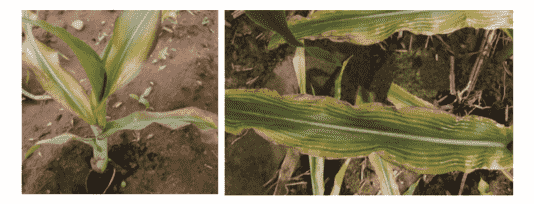
Causes of Magnesium Deficiency in Corn
Magnesium levels are generally low in acidic soils found in the southern regions and in sandy soils with high rainfall. The excessive application of acidic fertilizers and physiologically acidic fertilizers leads to soil acidification, which promotes the loss of magnesium from the soil. High application rates of potassium fertilizers or lime can cause magnesium deficiency due to nutrient antagonism.
Prevention and Remedies for Magnesium Deficiency in Corn
When magnesium deficiency symptoms appear, apply magnesium fertilizer as a foliar spray. Use a 0.2% magnesium sulfate solution and spray every week for 2–3 consecutive times to alleviate the symptoms. For fields with magnesium deficiency, magnesium fertilizer can be used as either a base or top-dressing fertilizer. Generally, apply 15 kilograms of magnesium sulfate or 10 kilograms of magnesium oxide per acre. When planting corn, prioritize using calcium-magnesium phosphate fertilizer and potassium-magnesium sulfate as sources of phosphorus and potassium fertilizers.
Corn Zinc Deficiency Symptoms
Severe zinc deficiency in corn leads to a condition known as "white stripe disease" or "white leaf stripe disease." The main symptoms appear between the third and fifth leaf stages. Young seedlings begin to show white discoloration, with new leaves turning pale yellow to white, particularly noticeable at the base of the leaf (2/3 of the leaf length). In severe cases, old leaves develop small white spots that quickly enlarge, forming localized white areas or necrotic patches. The leaf tissue becomes necrotic and translucent, resembling white silk or plastic film, and is easily broken by the wind. In the later stages, affected old leaves and leaf sheaths often show purplish-red or reddish-brown discoloration. Additionally, the internodes shorten, the root system turns black, tasseling is delayed, and the ears of corn may have missing or poorly filled kernels at the tip.
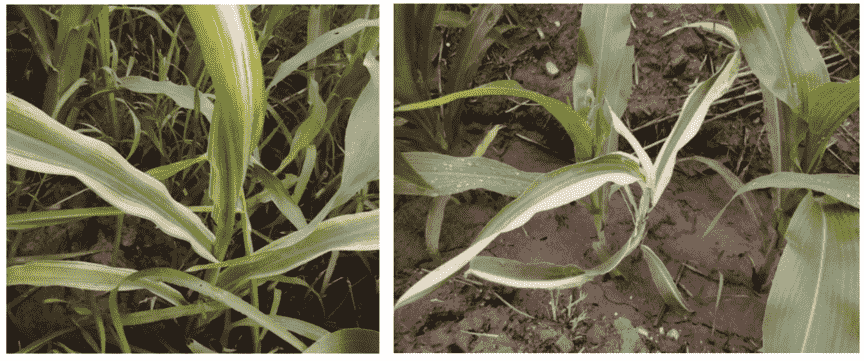
Causes of Zinc Deficiency in Corn
Zinc deficiency is common in calcareous soils, saline-alkaline soils, and marsh soils. Sandy soils, low temperatures, high humidity, or soils with low organic matter content are also prone to zinc deficiency. Excessive application of phosphorus fertilizer can induce zinc deficiency in crops. Over-application of nitrogen fertilizer can lead to insufficient available zinc in the soil. Long-term use of lime in acidic soils can alter soil pH and also cause zinc deficiency.
Prevention and Remedies for Zinc Deficiency in Corn
For soil zinc deficiency, apply 1–2 kilograms of zinc sulfate per acre as a base fertilizer, or mix 4–6 grams of zinc sulfate per kilogram of corn seed for seed treatment, or soak seeds in a 0.1%–0.3% zinc sulfate solution. When zinc deficiency symptoms are observed in corn, use a 0.2% zinc sulfate solution for foliar spraying at the seedling stage, jointing stage, and pre-tasseling stage. Apply 50–75 grams of zinc sulfate per acre for each spraying.
How to Grow High-Quality Corn?
Try our premium fertilizer—Wistom! We offer high-quality, high-tower granules directly from the factory. Featuring BASF's DMPP from Germany, it extends fertilizer effectiveness by 4-8 weeks. With high nitrogen content and mineral-derived humic acid, it contains no urea formaldehyde. Click here to learn more: MOQ: 26 tons. We are looking for global distributors.
FERTILIZER
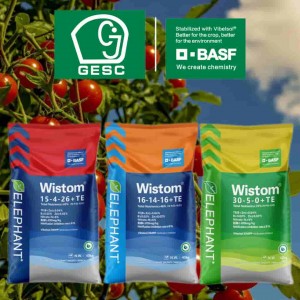
Post time: Aug-30-2024




